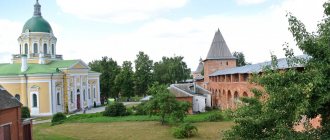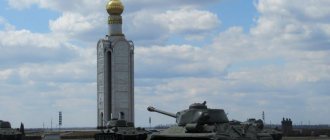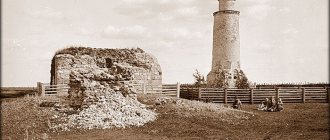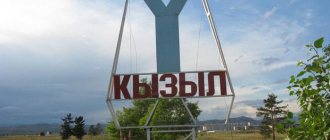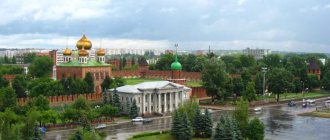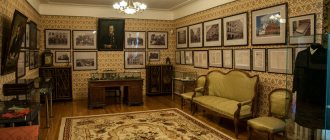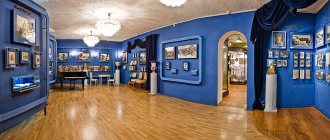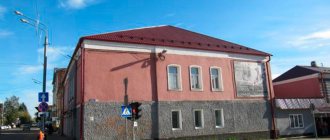We continue to talk about the cities of the Moscow region. Today, next in line is Dmitrov , founded by Prince Yuri Dolgoruky in 1154. Dmitrov was named after the youngest son of Yuri Dolgoruky - Vsevolod the Big Nest (at baptism he received his second name - Dmitry), who was born in the same 1154. During its history, the city was part of the Pereyaslavl Principality, the Vladimir-Suzdal Principality, the Galicia-Dmitrov Principality, the Dmitrov Principality and, finally, the Moscow Principality. On the way of the Mongol-Tatar raids on Rus', Dmitrov was defeated and burned several times. Now 66 thousand people live in Dmitrov, for the 850th anniversary of the city (by 2004) a large-scale improvement project was carried out for the city, in 2008 the city was awarded the title “City of Military Glory”. The Dmitrov Kremlin and the Boris and Gleb Monastery are the main one-day tourist routes.
Dmitrov Kremlin
The Dmitrov Kremlin was built in the 12th century as an ancient Russian border fortress. Nowadays there is a museum-reserve on this site, which includes 12 buildings (six of which are located on the historical square). The museum's fund includes about 40 thousand storage units.
Dmitrov's Zemlyanoy Val
The museum gates are open from 10 am to 5 pm; Closed: Monday and Tuesday. But even if you arrive outside of working hours, do not despair, because the entire territory of the Kremlin can be viewed from the once defensive embankments of the 12th century, closed around the Kremlin. The total length of the shafts is 990 meters, and the maximum height is 14 meters. Once on the ramparts there were wooden walls and towers of the Kremlin, which were not preserved due to frequent wars and fires. The Kremlin's earthen rampart is protected by the state.
Alexander Chapel
Or the chapel of Alexander Nevsky, the patron saint of all warriors. It was built in 1868 at the expense of the townspeople in honor of saving the life of Emperor Alexander II from an assassination attempt in 1866. The chapel is installed outside the Kremlin, in front of the Nikolsky Gate.
Nikolsky Gate
Nikolsky Gate (travel Nikolskaya Tower), was considered the main entrance to the Dmitrov Fortress from the north-western side and was burned in 1610 during the Time of Troubles, like the other 9 towers with a defensive wooden wall. The current wooden Nikolsky Gate was built in 2004, after which it burned and was restored several times.
Assumption Cathedral in Dmitrov
The architectural dominant of the Dmitrov Kremlin is the Assumption Cathedral. The cathedral was rebuilt several times, as a result of which it received 9 chapters (initially there were 5). The exact date of construction of the cathedral is unknown, approximately between 1509 and 1533. From 1932 to 1991 the temple was closed and transferred to the museum, the crosses were removed and the dome and spire of the bell tower were dismantled. In 2003, the temple and bell tower were completely restored and restored.
Gilded five-tiered iconostasis from the late 17th century.
Walking path from St. Nicholas Gate to the Assumption Cathedral.
In 2010, in front of the entrance to the Assumption Cathedral, a monument was erected to the Holy Martyr Seraphim, Bishop of Dmitrov. Bishop Seraphim served in the Assumption Cathedral of Dmitrov from 1920 to 1923. During this time, he founded the Brotherhood of the Life-Giving Cross of the Lord and was engaged in counter-revolutionary activities, for which he was sent into exile, and on August 23, 1937 he was sentenced to death.
A monument to the brothers Cyril and Methodius, who are known as the creators of the Slavic alphabet, was erected here in 2004. Cyril is holding a scroll with the Cyrillic alphabet in his hands, and Methodius is holding the Gospel.
Their image can also be seen inside the Assumption Cathedral on the wall.
Assembly of the Nobility
The building was built between 1877 and 1888. to accommodate military units stationed in the city. It became the building of the noble assembly a little later: in 1897. After the revolution of 1917, party and public organizations began to be located here: the Red Army club of the Dmitrov garrison named after Semenyuk, the party club, library and circles. After a fire in 1921, the second floor completely burned down, which was restored only in 2003. All this time, the remaining first floor was used as a school, workshops, and warehouses, until it fell into disrepair. Now the restored building is used by the museum to house art exhibitions.
Elizabethan Church
The Church of St. Elizabeth was built in 1898 and was assigned to the city prison, which is why the windows were reinforced with metal bars, and there was a balcony for guards on the second floor. Elizaveta Semyonovna Lyamina (wife of the owner of the Yakhroma spinning and weaving factory) donated funds for the construction of the church. In 1925 the church was closed and used as a village club and then as a storage building. In 1998, the church was returned to the Orthodox Church.
Prison building and outbuilding
The prison for which the Elizabethan Church was built is located right there (pictured in the center). The building was built at the beginning of the 19th century and served as a prison until the beginning of the 20th century. Later, the building housed: an improvement plant of the Executive Committee of the City Council, a funeral supplies store, and a laundry collection point. In the early 1980s. the building was transferred to the museum.
The outbuilding (two one-story extensions on the sides of the prison) was used as administrative buildings for the prison. Later the premises were converted into apartments for prison servants. Now the buildings have also been transferred to the museum, where museum funds are stored.
Gymnasium
The women's gymnasium (4 junior classes) was built in 1876 on the orders of Emperor Alexander II; girls from the most noble families of Dmitrov studied there. Along with it, six more new gymnasiums were built in Dmitrov. After 30 years, the pro-gymnasium was transformed into a full gymnasium with an 8-year course of study. There were 198 girls in seven subject classes, eight additional and two parallel preparatory classes. The gymnasium was financed from the city budget.
Behind the gymnasium there is a streetball court.
Parochial school
A former parochial school, it now houses the “Russian House” center for the development of creativity for children and youth.
Sovetskaya Square (formerly Upper Trading Square)
In front of the Dmitrov Kremlin lies Sovetskaya Square with a small walking alley. The square was also called Upper Trade Square and Revolution Square. The square received its current name in the 1920s, in connection with the Council of Workers', Peasants' and Soldiers' Deputies located here, and then the District Council.
Along the street there are buildings with shops, trading houses and cafeterias. It is worth noting that the entire area around the Kremlin is kept in perfect order, all thanks to the reconstruction of the city for the 850th anniversary (by 2004). For some reason, in Russia, cities look good only on anniversaries or before important competitions. They worked so well on Dmitrov that in 2005 the city took first place in the All-Russian competition “The most comfortable city in Russia” in the category “Up to 100 thousand inhabitants.”
The square is decorated with several fountains; on holidays, a stage is immediately installed.
Monument to Yuri Dolgoruky in Dmitrov
The main attraction of Sovetskaya Square is the monument to Yuri Dolgoruky, the founder of the city. According to legend, the monument is located in the very place where Yuri was predicted the birth of his son, after which he ordered the foundation of a city on this land. The monument was erected in 2001 as part of the same preparations for the city’s anniversary. Yuri Dolgoruky is “standing” with his back to the southern entrance to the Kremlin. Initially, this entrance did not exist; it was cut at the end of the 19th century.
On the opposite side of Sovetskaya Square there is a monument to V.I. Lenin (installed in 1950). It’s funny that the two leaders look and point with their right hands at each other; this can only be seen in Dmitrov.
Bridge of Happiness and Stone of Wishes
A modern landmark of the Dmitrov Kremlin is the Bridge of Happiness . It is believed that if you walk through two large horseshoes and five small ones supporting the bridge, good luck will smile. Along it, the groom must carry the bride in his arms in the name of Faith, Hope and Love. The entire bridge is hung with locks with the names of the newlyweds, and the keys to them must be thrown into the water.
Bridge of Happiness
Bridge of Happiness
Bridge of Happiness
Bridge of happiness. Horseshoe Bridge of Happiness
Next to the Bridge of Happiness there is a Wishing Stone with a broken horseshoe embedded in it. According to legend, Yuri Dolgoruky's horse tripped over a stone here and broke a horseshoe. The inscription carved on the boulder tells about this.
Stone of wishes Stone of wishes. Broken horseshoe
Zagorskaya street in Dmitrov
An eternal flame burns not far from the southern entrance to the Kremlin. The Eternal Flame memorial was installed at the end of 2001 on the site where the T-34-85 tank previously stood (the tank has now been moved to the exit from the city). Traditionally, the names of those killed during the Great Patriotic War are carved on a granite pedestal.
A little further: a park with a fountain.
Across the road is a residential building with a drawing calling for peace among all peoples.
Zagorskaya Street leads directly to the main building of the Museum and Exhibition Complex, which includes the Dmitrov Kremlin. The building was opened in 2004 on the site of an ancient settlement. The building houses exhibition halls, fund storage facilities and administrative premises, circles and clubs.
There is also a walking park with fountains.
Zagorskaya Street ends with the Constellation Palace of Culture: a yellow building with columns in the style of Soviet neoclassicism. The building houses the municipal theater “Bigger Nest”, where author exhibitions, concerts, creative meetings, theatrical performances, official events and city holidays are held.
Exposition
The exhibition space of the museum begins with the Dmitrov Kremlin and its surrounding territory. It is surrounded by an earthen rampart created in the 12th-16th centuries; at the moment it is a monument of defensive architecture. The buildings that formerly housed the Public Meetings and the Treasury now house the History and Art Department, which includes two independent exhibitions.
The museum's art collections are also extensive. From the point of view of the uniqueness of the collection, this is one of the most interesting places in the Moscow region. The department occupies the Public Meetings building. Among the exhibits are church art, decorative and applied arts, Russian and Western European painting of the New Age, folk art and art of the last century.
Kropotkinskaya street in Dmitrov
In 2003 (of course, for the 850th anniversary of Dmitrov), the pedestrian part of Kropotkinskaya Street on the eastern side of the Kremlin was improved: paved, houses were restored, lawns were tidied up, sculptures and monuments were installed.
View of Kropotkinskaya Street from the embankment.
At the very beginning of the street there is a monument to Peter Alekseevich Kropotkin (1842-1921), a Russian prince, scientist and revolutionary. P. A. Kropotkin was a researcher of the tectonic structure of Siberia and Central Asia. Famous historian, philosopher and publicist, creator of the ideology of anarcho-communism and one of the most influential theorists of anarchism. Behind him is the house of the merchant Novoselov . The Novoselov family was the most numerous in Dmitrov; it dates back to the 17th century, and by the end of the 19th century more than 10 Novoselov dynasties already lived in Dmitrov. Such a large family occupied several houses on the street, but to this day only one house, built in 1842, has survived.
The remaining sculptures on Kropotkinskaya Street are not tied to any individuals; they are designed to reflect the life and way of life of the city in the 19th century. A couple of young nobles walking along the Kremlin. By the way, here is the third (eastern) entrance to the Dmitrov Kremlin. When the Yegoryevskaya Tower passage stood at this place.
A merchant with a merchant's wife. The merchant has in his hand a wonder of that time - a watch.
Female teacher with magazines and ruler.
Bearded pilgrim with a staff.
Peasant woman with a cat.
If you have time, check out the “Tourist's Dream” gallery on the same street. In fact, this is a store, but also a free museum of various gizmos. Here you can see original works (dolls, interior decorations, dishes, etc.) made by masters of the Dmitrov region; exhibitions of collectors, artists and textile workers. You can also order a guide around the city or a master class (of course, for a fee).
Chess: red pieces are Rus', and black pieces are Tatar-Mangols.
Brief history of Dmitrov
In the 12th century, immediately beyond Dmitrov, impenetrable forests and swamps began, an area unsuitable for habitation. The city was the northwestern outpost of the Vladimir-Suzdal principality. Dmitrov occupied an important strategic position, covering the road to Suzdal along the Vela and Dubna rivers. By water from Dmitrov, through Yakhroma, Sestra and Dubna, one could get to the Upper Volga.
After Dmitrov went to Moscow in 1364, it belonged to one of the younger brothers of the Moscow princes. The first prince who lived and died here was Peter (1389-1428), one of the younger sons of Dmitry Donskoy . At the end of the 14th – beginning of the 15th century, during the period of civil strife between Dmitry Shemyaka and Vasily Kosy with the Moscow prince Vasily II the Dark, the city repeatedly changed hands. The last prince of Dmitrov was Yuri , the second son of Ivan III . Ivan the Terrible in 1556 exchanged Dmitrov for Staritsa from Prince Vladimir Andreevich Staritsky . After the execution of the latter in 1569, Dmitrov finally went to Moscow.
Dmitrov was ravaged many times by the Tatars, and in 1372 by Prince Mikhail of Tver . The city reached its heyday in the 16th century, during the reign of Yuri Ivanovich . According to Herberstein’s “Notes on Muscovy” (1549) and the Dmitrov customs charter, Dmitrov merchants traded salt, fish, caviar, bread, honey, tin, lead, etc.
In 2001, a monument to Yuri Dolgoruky (sculptor V. M. Tserkovnikov) was erected at the southern entrance to the Dmitrov Kremlin.
Monument to Yuri Dolgoruky near the Dmitrov Kremlin
Boris and Gleb Monastery
History has not preserved the exact date of creation of the Boris and Gleb Monastery; its oldest buildings date back to the 15th-16th centuries. The earliest mention of the monastery is indicated in the will of Prince Yuri Vasilyevich in 1472. The Boris and Gleb Monastery was repeatedly attributed to the composition of other monasteries. In 1682 they wanted to assign him to the Zaikonospassky Monastery, but the addition did not take place. From 1724 to 1726 was assigned to the Novgorod Bishops' House. Since 1764, the Boris and Gleb Monastery remains the only monastery in Dmitrov (Pyatnitsky and Nikitsky were abolished). Since 1926, the monastery has been closed and given to the local history museum. Since that time, the monastery has housed: a GULAG department for the construction of the Volga-Moscow canal, a military unit and various other organizations. Restoration of the monastery began in 1993; by 2004 it was completely restored and re-consecrated.
In 2006, a monument to princes Boris and Gleb was erected near the walls of the monastery - the first Russian saints, protectors of the Russian land and heavenly helpers of the Russian princes. Boris and Gleb were the sons of the Kyiv prince Vladimir Svyatoslavich (Vladimir the Red Sun), and were killed by their older brother Svyatopolk the Accursed.
The stone Cathedral of Boris and Gleb is the oldest building on the territory of the monastery and the center of the entire composition. In the 17th century, a three-tier hipped bell tower was added to it.
The Chapel of the Descent of the Holy Spirit was built next to the cathedral in 2004.
The Gateway Church of St. Nicholas was built under Archimandrite Kallistrat in 1685-1687 over the Holy Gates.
Abbot's house from the 19th century.
Monastic poultry house, also known as an aviary for peacocks. In the warm season, peacocks walk around the monastery!
